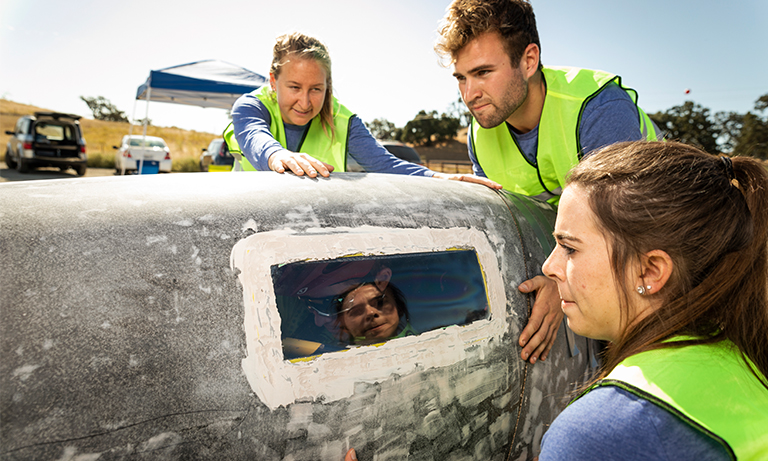On its last possible run, a human-powered vehicle created by a team of Cal Poly engineering students broke the American collegiate speed record Saturday, setting a mark that hadn’t been bested in nearly three decades.
The new record, 63.68 mph, was set during the 20th annual World Human-Powered Speed Challenge in Battle Mountain, Nevada, held Sept. 8-13. The previous record was 61.29 mph, set by a team from UC Berkeley in September, 1992.
An HPV is any vehicle powered by muscular strength. The most common HPV is a bicycle. Cal Poly’s HPV, named Ambition, competed against other enclosed recumbent bicycles that were designed, built and ridden by students. Professional teams also competed in separate categories.

Ambition was tailored-made for its driver, Josh Gieschen, a biochemistry major from Davis, California.
Battle Mountain is an optimum location for the event because of its thin air at 4,619 feet, which reduces aerodynamic drag. Riders travel down a 5-mile stretch outside of the town on State Route 305, on what organizers boast is one of the straightest, flattest and smoothest roads in the world, reaching their maximum velocity before being timed over a 200-meter distance.
The object of the event is to make the most aerodynamically efficient vehicles possible. Meanwhile, the technologies used for the HPV can apply directly to all forms of transportation.
Ambition is a front-wheel-drive bike covered with a bullet-shaped shell, made out of carbon fiber and Kevlar, to maximize aerodynamic performance. Members of the Cal Poly team split into subgroups specializing in different areas, such as the shell and drive train. Mechanical engineering seniors Derek Fromm of Seattle and Michael Juri of Fremont, California, developed the drive system.
While Cal Poly has had a human-powered vehicle team since 1978, this was the first time it attempted to break the record. After working on the vehicle for a year, the team had to make multiple significant changes in the days leading up to the race, adding a windshield and fixing a chain that repeatedly fell off.
“We had issues, but we knew we had time to fix them,” said Kyra Schmidt, the manufacturing lead.
The day before leaving for Nevada, though, they had a promising test run, Schmidt said, giving them confidence.
Still, there would be other factors – some out of their control. To qualify for a record, the wind can’t exceed be 3.7 mph. Some years, it’s simply too windy for anyone to qualify, Fromm said.
During the week, Ambition actually surpassed the record on Thursday, reaching 66.43 mph. But the wind speed disqualified it as a record-breaking run.
As the final day approached, wind was forecast to be above 3.7 mph in the evening. But the Cal Poly team had a window of opportunity earlier in the day.
“It was literally our last chance,” Fromm said.
Gieschen got off to a good start.
The so-called “motor,” who made 10 runs over the week — often racing twice a day — was tired and battling a cold. But his speed continued to increase until finally exceeding the 27-year record with “legal wind.”
And when it was over, Gieschen dramatically crashed at around 50 mph, the vehicle rolling over roughly three times.
Fortunately, Fromm said, Ambition was well built, and safety measures worked.
“Not a single thing broke on the bike,” he said.
Gieschen walked away with just a couple of small bruises.
“We are all super proud of everything Josh and the team accomplished,” said Schmidt, a mechanical engineering senior from Irvine, California.
Next year, the team is looking at 70 mph, she said – and, once again, she’s confident they can do it.
“We are excited to continue improving and come back even better next year — but first, we can all take a well-deserved break.”


